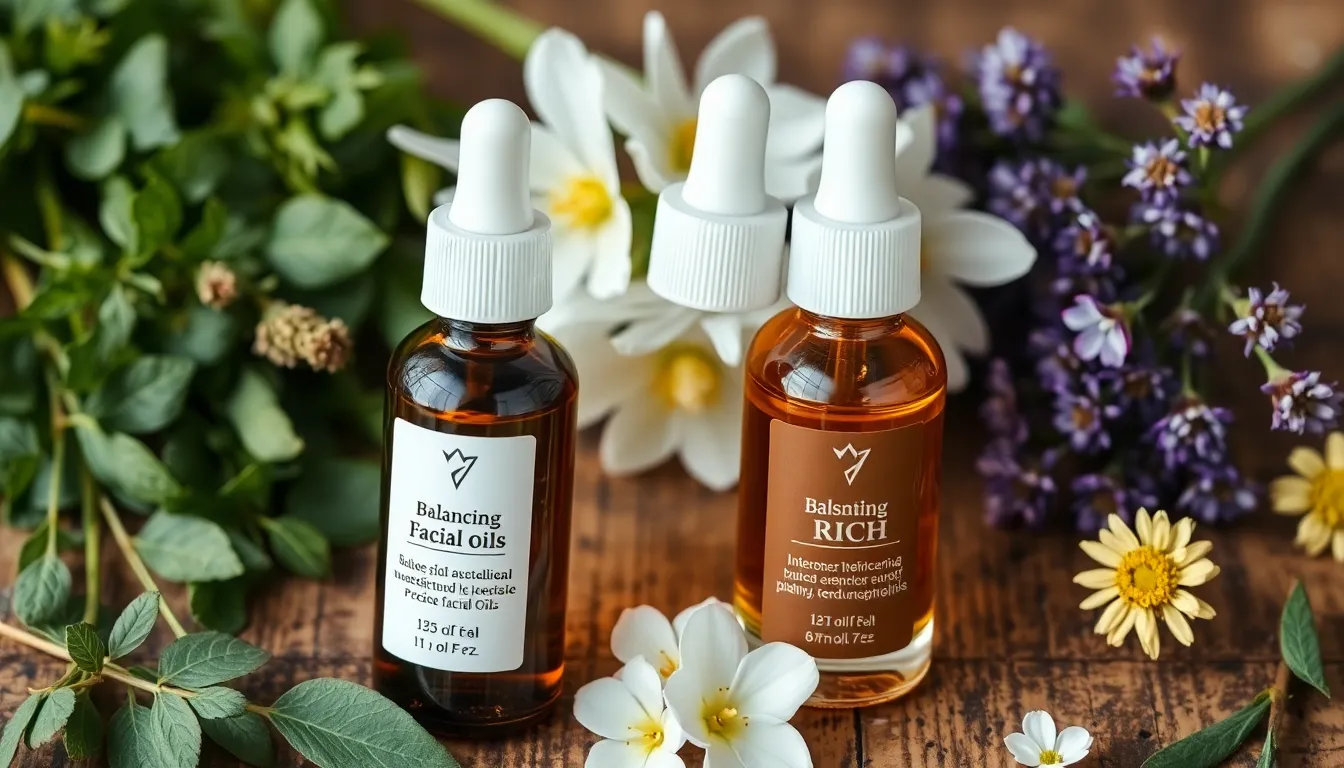In the quest for radiant skin, balancing facial oils might just be the secret weapon everyone’s been waiting for. Imagine a world where your skin feels hydrated without looking like a greaseball. Sounds like a dream, right? Well, it’s time to wake up and embrace the magic of the right oils!
The beauty industry has been buzzing about facial oils, but not all are created equal. Finding that perfect balance can feel like searching for a unicorn in a haystack. With the right knowledge, he or she can transform their skincare routine and say goodbye to dullness and hello to a dewy glow. Let’s dive into the art of balancing facial oils and unlock the secrets to a complexion that’s as smooth as a freshly buttered muffin.
Table of Contents
ToggleUnderstanding Balancing Facial Oils
Balancing facial oils provide hydration without excess shine, playing a crucial role in skincare routines. Selecting the right oils can enhance the skin’s overall texture and appearance.
What Are Balancing Facial Oils?
Balancing facial oils consist of lightweight formulations that maintain skin moisture levels. These oils typically include jojoba, squalane, or rosehip oil, which mimic the skin’s natural sebum. They promote hydration while preventing excessive oils from accumulating. Utilizing balancing facial oils can help restore the skin’s balance, resulting in a smoother complexion.
Benefits of Using Balancing Facial Oils
The benefits of using balancing facial oils are numerous. They effectively hydrate the skin, promoting a healthy and radiant glow. Reducing the appearance of fine lines and uneven texture occurs as the skin retains moisture better. These oils also enhance the skin barrier, improving resilience against environmental stressors. Incorporating them into daily routines can lead to a significant improvement in overall skin health and luminosity.
Types of Balancing Facial Oils

Balancing facial oils come in various types, catering to different skin needs. Understanding these types helps in selecting the right oil for specific concerns.
Lightweight Oils
Lightweight oils offer hydration without feeling heavy. Oils like jojoba and squalane absorb quickly, making them ideal for oily or combination skin. These oils closely resemble the skin’s natural sebum, promoting balance and preventing excess shine. Additionally, they help to soothe irritation and minimize the appearance of pores. Users can enjoy a smoother texture while maintaining adequate moisture levels.
Rich Oils
Rich oils provide deep nourishment, perfect for dry or mature skin types. Oils such as rosehip and argan deliver essential fatty acids and antioxidants, promoting skin repair and hydration. Their thicker consistency creates a protective barrier, shielding the skin from environmental stressors. While they’re excellent for evening routines, users should apply them sparingly during the day to avoid greasiness. Heavy-duty hydration leads to improved elasticity and a more youthful appearance.
How to Choose the Right Balancing Facial Oil
Selecting the right balancing facial oil hinges on understanding individual skin types and concerns.
Skin Types and Concerns
Oily skin benefits from lightweight oils that absorb quickly. Jojoba oil mimics skin’s natural sebum, providing moisture without clogging pores. Combination skin also thrives on these oils, maintaining hydration in dry areas while controlling excess shine. For dry skin, rich oils offer deep nourishment. Rosehip oil provides essential fatty acids and antioxidants that enhance skin repair. Mature skin particularly needs these nourishing properties; incorporating heavier oils can diminish the appearance of fine lines. Tailoring oil choices to specific skin needs ensures optimal results.
Ingredients to Look For
Identifying beneficial ingredients enhances oil selection. Jojoba oil features high stability and compatibility with various skin types. Squalane, derived from olives or sugarcane, locks in moisture effectively. Rich oils like argan and rosehip contain antioxidants that combat environmental stressors. Look for oils packed with vitamins A, C, and E, which promote skin health and vibrancy. Avoid oils high in comedogenic ratings, as these can aggravate breakouts. Prioritize oils with natural, organic certifications to ensure quality and efficacy.
Application Tips for Balancing Facial Oils
Applying balancing facial oils correctly maximizes their benefits for healthy skin. Following specific methods enhances the experience and effectiveness of these oils.
Best Practices for Application
Start with clean skin to ensure better absorption of facial oils. Warm a few drops of the selected oil between the palms, which helps activate its properties. Pat the oil gently onto the face rather than rubbing it in, focusing on dry areas. Focus on areas with fine lines or uneven texture for best results. Layering oils over a hydrating serum can boost hydration levels. Using a facial roller can also help distribute the oil evenly, reducing puffiness.
Frequency of Use
For oily skin types, using balancing oils 2 to 3 times a week suffices. Combination skin may benefit from daily application, particularly in dry areas. Those with dry skin should consider using oils both morning and night for maximum hydration. Mature skin typically thrives on consistent use, integrating oils into the skincare routine daily. Adjusting frequency according to individual needs is essential, noting any changes in skin texture or hydration levels.
Balancing facial oils can truly transform a skincare routine. By choosing the right oils tailored to individual skin types, one can achieve hydration without greasiness. Lightweight oils work wonders for oily and combination skin, while rich oils provide the nourishment dry and mature skin craves.
Incorporating these oils effectively enhances skin health and radiance. With the right application techniques and frequency, anyone can unlock the benefits of these natural wonders. Embracing the art of balancing facial oils not only promotes a smoother complexion but also boosts confidence through healthier skin.






